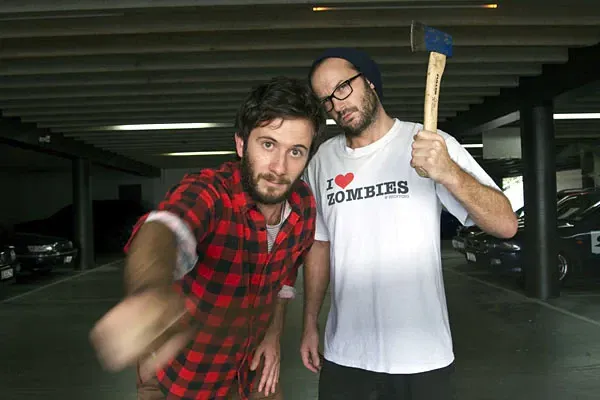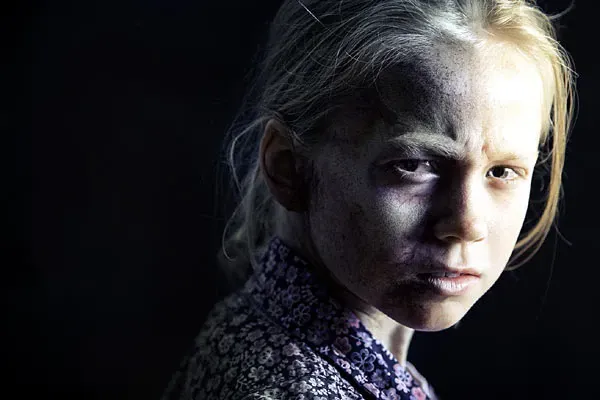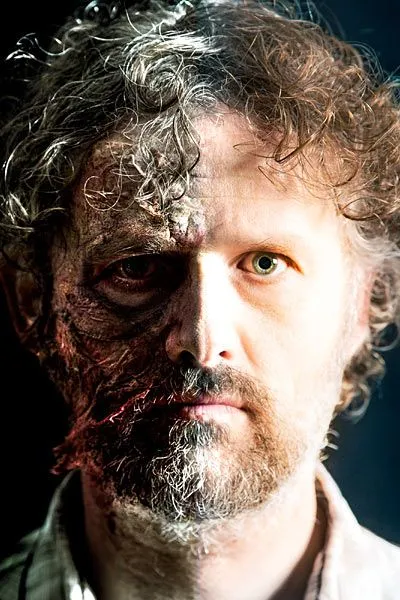Surviving Apocalypse Z

This month, Apocalypse Z makes real the threat of a zombie disaster taking over Auckland.
Renee Liang talks to Simon London and David Van Horn, co-creators of this fully immersive show.
* * *
Have you seen the posters in the Auckland CBD warning of imminent doom? Take heed, for this month, the dreaded contagion of virus Z will spread, killing most of the population. Survivors should head to the only safe place, a military outpost in Aotea Square.
And so Apocalypse Z begins. It’s fully immersive theatre, a dream come true for those who have ever wanted to be in a zombie movie. In fact, it’s better than a movie or game. You can’t sit back. You have to run, make decisions that will affect the storyline, and take action as one of the survivors. I spoke to co-creators, Simon London and David Van Horn.
What gave you the idea for this show?
Simon: The idea came to us when Dave and I were sitting on his veranda one night about four years ago. It grabbed us immediately. I remember us imagining what it would be like to start it with a couple of characters running through a car park towards a waiting audience, screaming at them and rushing them inside. That hasn’t made it into the show but the concept hasn’t changed. A live horror show where the audience can't sit back and feel safe. They are inside it.
David: We were actually developing another show at the time and the idea for a zombie show just popped out as a joke. We got totally side tracked and couldn’t stop jamming ideas for the show. The idea was so strong that it wouldn’t actually let us go. The more it gained interest, the more we took it seriously. Plus, we just wanted to look badass on stage.
Why theatre, and why zombies?
D: It was a time in our careers when we wanted a bit more of control and to create work that excited us. Theatre has been huge in our development as actors so it makes sense that we would work in that medium. What is great about zombie films, books and videogames is that they are about human survival and how we deal with the world as we know it falling apart. Perfect setting for a dramatic theatrical rollercoaster ride.
S: Theatre is a medium that really hasn’t mastered horror yet. But it's perfect for it. People feel so much more exposed in a live situation. There's Spookers for people who just want a fright but we wanted to make something with a real narrative to it. A theatrical story that spirals out of control with characters that lead the audience through hair raising situations and serious moral dilemmas. This idea has to be live to achieve the immersion which makes it so special.
So, um, are you absolutely sure that audience members won’t be in danger during the show?
S: Weeeell. Yeah they'll be safe. Even if they don't feel it. We obviously don't want to hurt anyone. I guess the biggest danger is cardiac arrest.
D: And they might have to wash their undies after.
How have you approached the writing – and how do you work as co writers?
S: We've played with all sorts of writing techniques on this. We've been through so many versions of the show. We’ve looked at screenwriting structure, seeing as we wanted the show to be like being in a zombie movie. Early on we did a devising workshop with John Bolton which was really useful. A lot of the time we’d just sit down together, draw up big diagrams or work through it scene by scene and other times we’d work bits separately. Pip Hall came on board as our dramaturg and she’s given us loads of helpful guidance and run a couple of script development workshops for us. Then in rehearsal, with the set and production resources evolving, we’ve continued to rework it with Andrew and the cast.
D: Google docs has been amazing. There was a time when we were in different countries working on the script and having meetings on Skype. It’s required a lot of trust in each other, especially when one of us is busy on another project and the writing is left to the other person. We’ve talked about it for so long now that we no longer know who came up with what. It’s true collaboration. We worked really hard on the structure of the piece and trusted in our director and cast to bring the scenes to life on the rehearsal room floor.
Movies, TV, gaming – lots of people reckon they know what how a zombie looks and moves. How do you suspend disbelief in at close quarters? Can you let us in on any staging secrets?
D: A lot of times in good horror films it’s the anticipation of the monster. So it’s about building the tension and the idea of what is just around the corner. That way people do the work themselves and build in their mind the scary details.
S: And we’re making full use of brutal and bloody makeup. We’ve got an amazing special effects makeup team, led by Shay Lawrence of Spartacus.
‘We want people to be involved but we also want to make this terrifying ride as comfortable as possible, audience members choose to be involved as much or as little as they want.’ How do you design an interactive theatre piece so people will jump in?
D: The characters will be connecting with each and every audience member during the show. So we hope to build a confidence in our characters that when they ask for help people will be willing to put their hand up.
S: And if people want to stand back and just get carried along by the group they can.
How did you persuade the authorities to let you construct a military fort in Aotea Square?
S: We didn’t have a choice actually. We originally wanted to just do it in the Basement Theatre building but when The Edge came on board they insisted we to do it as a site specific piece in the square. So it morphed from what we planned to be a ‘cardboard’ production in the basement into this big beautiful terrifying extravaganza.
D: We got told to write without restriction and it would be up to the production team to try and make that happen.
Can you talk about Andrew Foster’s set design?
S: Being the director as well as the set designer means he has an extra level of understanding when it comes to what is required of the set and also how he can design the set to influence the story. We always imagined lots of shipping containers and fencing but Andrew’s configuration and method has really enhanced the way the action unfolds.
D: Andrews design is going to take the script to the next level! We had loads of ideas for what we wanted and he’s managed to work them all in with his flash touch on it.
How many people are involved in the production?
S: We’ve got seven actors and a horde of at least fifty zombies. The technical and production team are well over ten people on top of that. And all for this crazy idea we had on Dave’s veranda one night!
D: It’s amazing to think that all these people have come on board with so much passion for this idea. I love sitting in meetings listening to everyone seriously discuss zombies. It cracks me up.
Aside from knowing how to survive a zombie apocalypse, what do you hope audience members will leave with?
S: Who says they’ll survive?
D: A buzz to see more!
What are you working on next?
S: Apocalypse Z is all consuming and may be for a while yet. We’ve got high hopes for taking it elsewhere once we’ve got this season over the finish line. I’ve got a life in Sydney too so I need to get back and keep developing things there.
D: Hopefully future productions of Apocalypse Z! Want to take this puppy all over the world! Surprisingly the writing bug hasn’t been completely killed in me, so will continue to learn more about writing technique and develop scripts. I’m working with ATC later this year when Fasi and I tour Niu Sila. It’s a dream come true to do that play with him. So with Niu Sila to look forward to and finally staging Apocalypse Z, it’s a good year for me. A year of playing pretend with my friends. Do what you love, with people you love.
APOCALYPSE Z | Immersive Theatre
What will you to do survive?
Aotea Square, April 12-27

